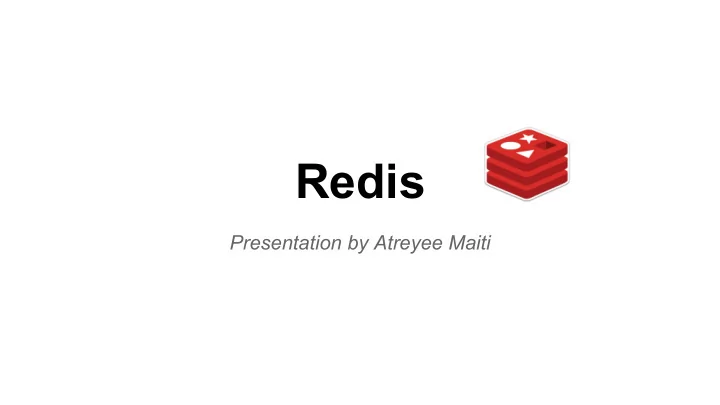

Redis Presentation by Atreyee Maiti
What is redis? ● an in-memory key-value store, with persistence ● open source ● written in C “can handle up to 2 32 keys, and was tested in practice to handle at ● least 250 million of keys per instance.” - http://redis.io/topics/faq most popular key-value store - http://db-engines.com/en/ranking ● History: ● REmote DIctionary Server ● released in March 2009 ● built in order to scale http://lloogg.com/
Features ● abstract data types - Lists, Sets, Sorted sets of strings (collections of non-repeating elements ordered by a floating-point number called score), Hashes ● two kinds of persistence mechanisms ● replication ● publish subscribe ● transactions (with optimistic locking) ● Lua scripting ● command line tool
Redis protocol
Persistence mechanism RDB(Redis snapshotting) and AOF(Append-only file) ● The RDB persistence performs point-in-time snapshots of dataset at specified intervals. ● The AOF persistence logs every write operation received by the server, that will be played again at server startup, reconstructing the original dataset. Commands are logged using the same format as the Redis protocol itself, in an append-only fashion.
Copy on write via forking http://nosqlberlin.de/slides/NoSQLBerlin-Redis.pdf
Replication ● redis master - handles all reads/ writes ● slave - hot standby - can also be configured for scalability to serve reads ● sentinels - mechanism for monitoring, failover - uses pub/sub, gossip and agreement protocols
Transactions
To redis or not? ● Counting Downloads ● High Score tables ● Caching ● Queues ● coupling with other databases My two cents :) ● using resque for managing background jobs ● jobs placed on queues ● used sentinels for HA
So who is using redis? Source: http://redis.io/topics/whos-using-redis
USP ● in-memory with persistence ● supported data types ● pub/sub ● queues ● support for a whole lot of clients
Source: http://redis4you.com/articles.php?id=003
Comparison Redis Mongodb Couchdb Stock prices. Analytics. For most things that CRM, CMS systems. Real-time data you would do with For accumulating, collection. Real-time MySQL or PostgreSQL, occasionally changing communication. And but having predefined data, on which pre- wherever you used columns really holds defined queries are to memcached before. you back. be run. Places where versioning is important.
References http://nosqlberlin.de/slides/NoSQLBerlin-Redis.pdf http://stackoverflow.com/questions/7888880/what-is-redis-and-what-do-i-use-it- for http://highscalability.com/blog/2011/7/6/11-common-web-use-cases-solved-in- redis.html http://openmymind.net/redis.pdf http://oldblog.antirez.com/post/redis-persistence-demystified.html http://redis4you.com/articles.php?id=003 http://blog.siyelo.com/redis-in-the-nosql-ecosystem http://www.slideshare.net/tim.lossen.de/cassandra-vs-redis
Recommend
More recommend